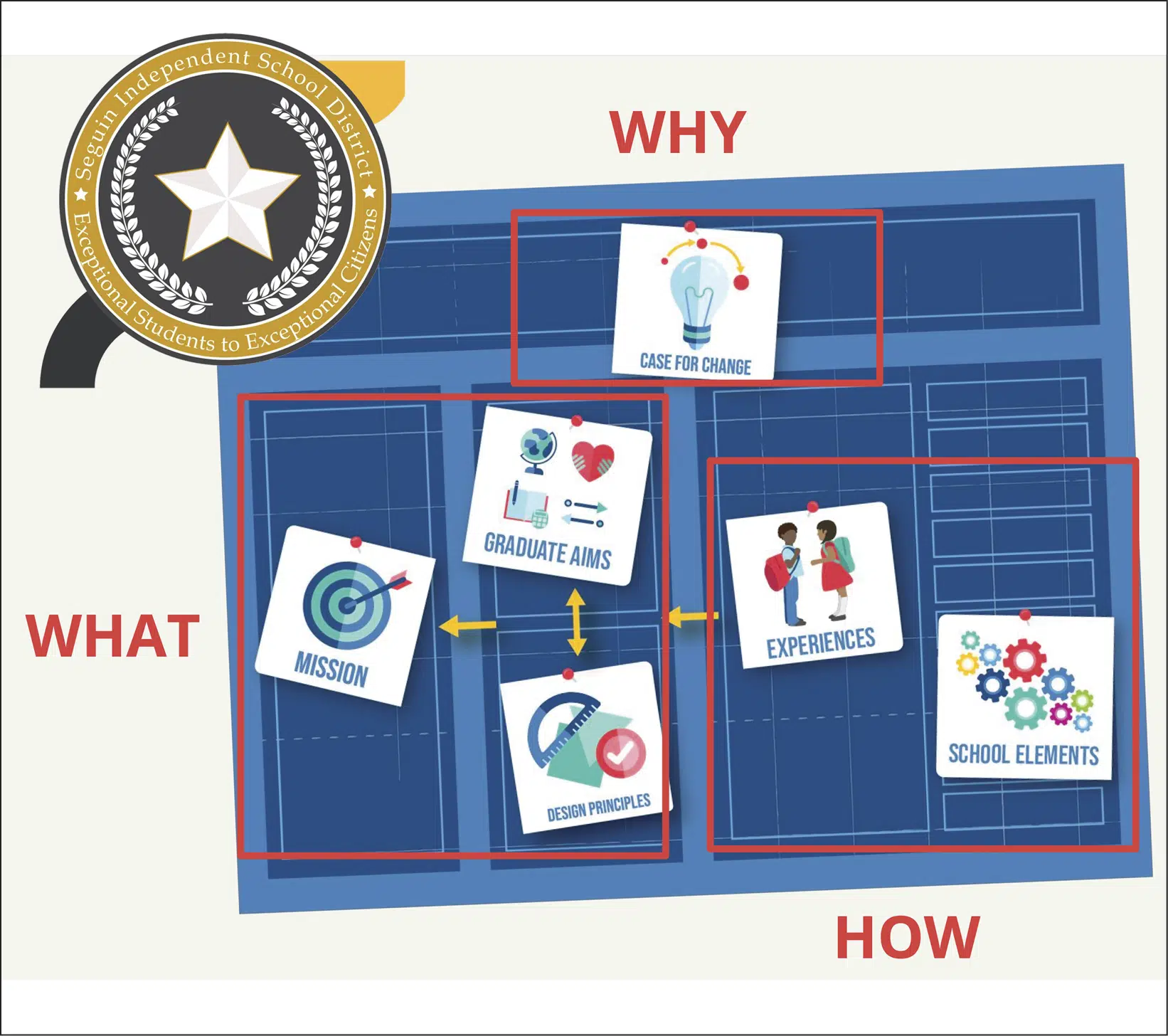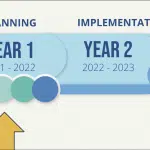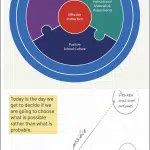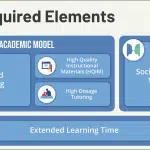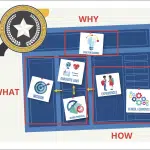Seguin ISD approves new Great Schools Middle School Redesign
(Seguin) — The Seguin ISD next school year will be rolling out the new innovative blueprint for academic success and total student well-being at both of its middle schools. With this rollout, the school district is giving middle school students and parents the opportunity to learn more about how things will be different.
Helping families take note of these changes is Mark Cantu, chief innovation officer for the Seguin ISD. Cantu says this new concept is part of what’s being called the TEA’s System of Great Schools Middle School Redesign. He says when TEA announced last year that they had been assigned money to offer a grant opportunity to address COVID learning gaps, the district jumped at the opportunity, and received $750,000 (to be paid over three years) for each of the middle schools.
As part of the redesign program, Cantu says the district was paired up with Transcend, a school design consultant, and through that work they were able to launch a pilot program with the sixth-grade class at Barnes.
He says as the district moves into next school year, the program will be extended to all grade levels at both middle schools. He says that’s why it’s important that families learn the five student experiences that will be incorporated into the day to help not only meet TEA’s grant requirements but to help bridge those gaps in learning and behavior.
Cantu says the first two TEA required academic elements include Blending Learning and High-Quality Instructional Material.
“So, one of them is Blended Learning Opportunity and so we had already been doing some of that and Blended Learning is having students on a computer through a station rotation model. So, it looks very similar to what happens in elementary, right? In elementary, we see centers or groups of students working individually. TEA is saying one of those has to be a technology or a computer station. So, we said check we can do that. We’ve just got to plan for what it looks like in the middle school. The other component they say is you have to include what they are calling High Quality Instructional Material. So, the TEA has gone and done some research with other partners and has said, ‘here are some instructional materials that we believe are best to enable us to really close those COVID gaps or that learning loss that happened because of COVID and so we need to adopt that in reading and in math. We were already piloting that – that was one of our pilots in sixth grade at both middle schools which was called Carnegie Math and so we said ‘okay, we can do that, check, move along the way,’” said Cantu.
Cantu also gives a closer look at the third and fourth elements which include High-Dosage Tutoring and Social-Emotional Wellbeing.
“The other thing that TEA also says is you must include High Dosage Tutoring. So, we know that with strong curriculum and with time, we can close those COVID gaps or that learning loss and so, TEA says dedicate 90 minutes a week to High Dosage Tutoring. We’ve also piloted that. This we did it at Barnes, sixth through eighth grade. So, we said okay, ‘we can do that, check, let’s keep moving forward.’ The next one is Social and Emotional Well Being, so we know that students’ mental health has really been impacted especially the last couple of years. It was something that already existed, but it was just brought to the forefront even more. So, we have to include something to adjust that. Barnes had also been using this school wide 6-8th grade and it’s a curriculum called Character Strong. Once AJB took a look at it, they really liked it too and they said okay, ‘we can incorporate that into our school day.’ Both campuses were already doing some SCL (student centered) lessons 6 through 8 grades anyway, but AJB will now follow that scope and sequence,” said Cantu.
Cantu says helping to pull all these elements together is the fifth component of Extending Learning Time.
“The last thing that they said is that you have to include some sort of Extended Time, Extended Learning. We have to give students a greater opportunity to be able to accelerate that learning especially due to COVID. So, one of the things that we are proposing is a new school start time that starts at 8 o’clock instead of 8:10 so it gives us 10 minutes a day and the other thing is this year, we had a different grant, the ACE Grant and both middle schools plus the seven elementary schools have the ACE Grant and that extends the school day up until 7 o’clock for those ACE students which we have about 100 at each middle school campus. Those are the five components when we saw the opportunity, we applied for the opportunity, and it’s been a full year process, so we are in year one of the process. Next year, we launch and then, we have the rest of the funds to use between the next school year and the following school year,” said Cantu.
As families prepare for the upcoming school year, Cantu notes a couple of things that families and students will notice immediately from this new middle school redesign.
“I know traditionally we’ve started elementary at 8 a.m. and then we gave 10 minutes between the middle school and the elementary and so now they will both start at 8 and so I know that that may cause some challenges for parents and all we are asking is that we understand that it may be an issue but that we just plan so that our students can arrive at the elementary if they have an elementary student and at the middle school before 8 o’clock so I think that’s the first thing that parents will notice. The other thing that they will notice and hopefully, students come home talking about their experience is their schedule will look a little different Monday through Thursday. Because of that extended learning time, we have 60-minute classes. In the past, currently this school year, students have 47-minute classes and so those 60 minutes, I think they end up being 58 minutes to be exact – we hope that students will and teachers will use that additional time to be able to implement that more rigorous curriculum,” said Cantu.
In moving toward this completely new way of learning, Cantu says middle school students will no doubt hit the ground learning. He says luckily, the pilot concept at Barnes has proven that idea. Plus, he adds that Fridays or in this case, Flex-Fridays, will look a whole lot different from a student’s Monday through Thursday schedule.
“So, the third thing that I think that students will see that is a little different and we experienced it with the sixth grade is the curriculum is more rigorous and so it really challenges students in ways that they haven’t been challenged the last couple of years. We know that we have to engage students in small groups. They have to get back into the routine of working together, of building those social skills, having academic conversations, having discussion, having discussions about how to get answers, how to solve problems so I think that is something that the students will experience, and the last thing is on Friday, the Friday student experience looks a little bit different so those are longer blocks of time. So instead of having a 58-minute period, the student will have three 90-minute periods where they will engage in project-based learning that is tied to their choice. We won’t have 30 different choices, but we will have several choices and then it will tie somehow back to either math or the humanities and so that is what will look the most different from the typical schedule that we typically run this year or that we’ve done in the past,” said Cantu.
Cantu says the district also believes that this new curriculum and schedule will allow for less behavioral issues. He says the curriculum elements just allow for a heavily focused school day.
“Because there is higher levels of engagement, because there are small group conversations, because there is small group engagement because students are working with their peers, there should be less time for distractions or there should be less times for students to be sitting idle or not have a full lesson and so we continue to work. There are pieces that we also piloted just a few weeks ago about how do you have a conversation with students so that they set a goal? So, that when they are working independently, they continue to build their stamina. So that goal setting conference with the teacher might be something like, ‘hey Mark I noticed that during the small group instruction while I was trying to teach my small group, you and Cindy were having a conversation that was off topic. You need to be self-directed so what can you do? Let’s set a goal so that you can continue to get better and yourself directed and you stay on task. That is what some of those goal setting conferences can look like and that’s part of rolling out this Blending Learning model,” said Cantu.
Informational meetings about this new redesign concept will continue to be scheduled at each of the respective middle schools. The district hopes to again share news about this new concept closer to August. The design was officially approved by the Seguin ISD Board of Trustees during Tuesday’s meeting.





